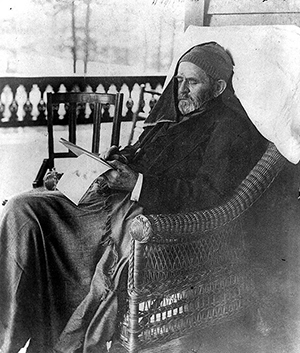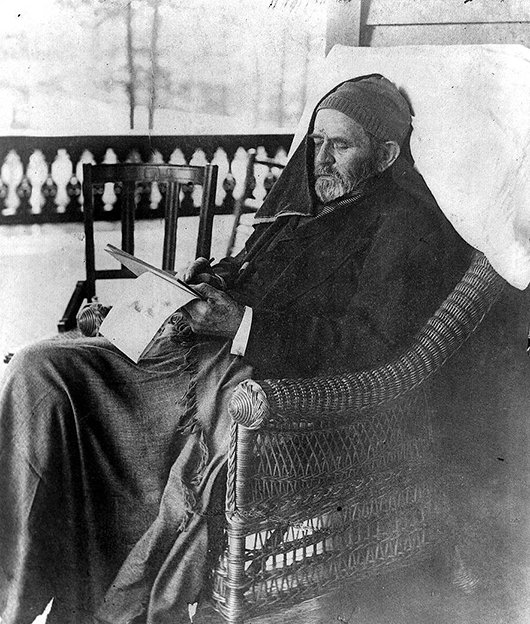
During the Civil War, his forces fought at Shiloh, Tenn., and into North Mississippi in the spring of 1862. By the end of that year, the siege of Vicksburg began and lasted until July 4, 1963, when Union troops successfully took the Mississippi River city.
Despite that contentious history, Grant and Mississippi have a future together.
The 18th president of the United States was born in Ohio and buried in New York, but a large part of his legacy resides at Mississippi State University’s Mitchell Memorial Library.
It’s a massive archive of original letters, diaries, photographs and other memorabilia, as well as copies of Grant’s papers that are on file at the National Archives, the Library of Congress and around the world.
Among the contents is an order Grant wrote while in Oxford that President Lincoln promptly rescinded. In addition, there’s a real-life piece of an abolitionist leader, as well as photographs of the most well-attended funeral of all time.
“We’re talking about 16,000 linear feet of materials,” said Ryan Semmes, assistant archivist with MSU’s Congressional and Political Research Center. “We are amazed. Every week we find something here. Not lost, just waiting to be found again.”
The collection is a treasure trove for scholars, students and lovers of history, and just about everyone who visits has one question on their minds.
“They want to know why Mississippi? That’s the first thing people ask,” said John Marszalek, executive director and managing editor of the Ulysses S. Grant Presidential Library.
The answer goes back to the 1960s, when the Ulysses S. Grant Association decided to collect all of his letters, manuscripts and other items in one place.
It started at Ohio State in 1962 then moved to Southern Illinois University in 1964 until 2008, when the association decided to move the collection to MSU.
“Dr. Marszalek is a nationally and internationally known scholar,” said Frances Coleman, dean of University Libraries. “When he was made executive director of the collection that had a lot to do with its coming here.”
The Giles distinguished professor emeritus, Marszalek taught history at MSU since 1972, and had retired twice. He came out of retirement again when asked to take the executive director’s role after his predecessor, a professor at Southern Illinois, died.
Cole and MSU President Mark Keenum also campaigned to get the collection in Starkville.
“It came here because Mississippi State made the best offer, the best arrangements and offered the best support,” Marszalek said.
“Our wanting the collection here was on behalf of students,” Cole said. “We recognized its value in support of history and the scholarship of history.”
It took an out-of-court settlement to get Southern Illinois University to relinquish the collection.
Since the move, the 31st and 32nd volumes of Grant’s papers have been published. Almost all of the volumes have been digitized and made available online.
Marszalek said there are plans to publish an annotated version of Grant’s autobiography, a hugely popular book in its day.
“The book came out after Grant died. The $300,000 royalty check went to his widow,” Marszalek said. “At that time, it was the biggest royalty check in history.”
The items on display include a massive book called Seven Mile Funeral Cortege of Genl. Grant, a hardbound book of photographs depicting the mourning that followed Grant’s death on July 23, 1885.
“His funeral to this day was the biggest funeral in U.S. history. He represented the salvation of the Union,” Marszalek said. “Grant’s tomb was the most popular tourist attraction in New York until the 1920s, bigger than the Statue of Liberty or anything. Grant’s tomb was where you would go.
“We’ve got a Major League individual here, of whose collection we administer.”
The archive contains the positive and the negative from Grant’s life. General Order No. 11, which he issued while in Oxford on Dec. 17, 1862, is among the low points.
“He basically kicks out the Jews who are sutlers in the army,” Semmes said. “Sutlers were merchants who followed the army, and he kicks them all out, blaming them for ripping off the soldiers.”
When word reached President Lincoln and prominent American Jewish citizens, the order was rescinded.
The archive has afforded MSU students the chance to get familiar with what it means to actually work with history.
By its very nature, such a vast archive of materials is unwieldy.
“Our job as archivists is to make the process of finding things easier,” Semmes said. “Still, there are 16,000 feet of linear materials, so we can’t go item by item. We have to group items together.”
That means the archive is ripe for discovery, and scholars from around the country and the world have come to plumb its depths. Mississippi State students get access, too, and one made an exceptional find early in his searching.
“A graduate student was doing some archiving stuff for us and discovered a lock of Frederick Douglass’ hair,” Marszalek said.
In the 19th century, it was common to ask someone for a lock of their hair, as a Quaker girl did of Douglass in Pendleton, Ind., some 10 years after the Civil War.
Decades ago, a researcher interviewed people who were there and verified the find, which later became, as Semmes said earlier, “Not lost, just waiting to be found again.”
Marszalek said the student who discovered the hair got the wrong idea about research.
“I had to sit him down and say, Look, you don’t understand. Historians work all their lives and don’t have the experience you had so early,’” Marszalek said.
MSU is in the planning stages to expand Mitchell Memorial Library. That would provide more space for the collection that continues to grow.
“In the last six months,” Marszalek said, “we’ve gotten three letters that Grant wrote that are in a Japanese university.”
It’ll probably always seem a little odd for a Mississippi school to house the presidential library of the Union’s commanding general. Marszalek, Cole and the rest know the question will keep coming up.
In a nod to that continuing curiosity, the library had bookmarks printed to explain why the home of the MSU Bulldogs might be the perfect place for Grant’s legacy.
“Hold on with a bull-dog grip, and chew & choke, as much as possible,” Lincoln wrote to Grant on Aug. 17, 1864.
“See?” Marszalek said. “It was meant to be.”
___
Information from: Northeast Mississippi Daily Journal, http://djournal.com
Copyright 2013. Associated Press. All rights reserved. This material may not be published, broadcast, rewritten, or redistributed.
AP-WF-11-30-13 1703GMT
ADDITIONAL IMAGE OF NOTE



